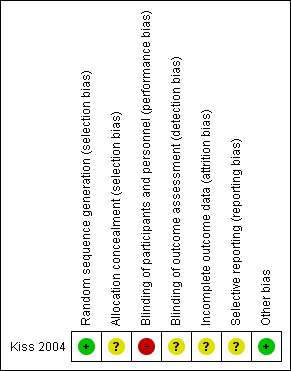Programas de cribado y tratamiento de infecciones del aparato genital inferior para la prevención del parto prematuro
Appendices
Appendix 1. CENTRAL search strategy
#1 MeSH descriptor Pregnancy explode all trees in MeSH products
#2 MeSH descriptor Pregnancy Complications explode all trees in MeSH products
#3 pregnan* in All Fields in all products
#4 (preterm or premature) near (labour or labor) in All Fields in all products
#5 MeSH descriptor Infection explode all trees in MeSH products
#6 MeSH descriptor Mass Screening explode all trees in MeSH products
#7 screen* in All Fields in all products
#8 infect* in All Fields in all products
#9 (#1 OR #2 OR #3 OR #4)
#10 (#5 OR #8)
#11 (#6 OR #7)
#12 (#9 AND #10 AND #11)

Risk of bias summary: review authors' judgements about each risk of bias item for each included study.

Comparison 1 Lower genital tract infection screening versus no screening, Outcome 1 Preterm birth less than 37 weeks.

Comparison 1 Lower genital tract infection screening versus no screening, Outcome 2 Preterm very low birthweight (below or equal 1500 g).

Comparison 1 Lower genital tract infection screening versus no screening, Outcome 3 Preterm low birthweight (below or equal 2500 g).
| Lower genital tract infection screening versus no screening for preventing preterm delivery | ||||||
| Patient or population: pregnant women presenting for routine prenatal care | ||||||
| Outcomes | Illustrative comparative risks* (95% CI) | Relative effect | No of Participants | Quality of the evidence | Comments | |
| Assumed risk | Corresponding risk | |||||
| No screening | Lower genital tract infection screening | |||||
| Preterm birth less than 37 weeks | Study population | RR 0.55 | 4155 | ⊕⊕⊕⊝ | ||
| 53 per 1000 | 29 per 1000 | |||||
| Preterm low birthweight (below or equal 2500 g) | Study population | RR 0.48 | 4155 | ⊕⊕⊕⊝ | ||
| 51 per 1000 | 24 per 1000 | |||||
| Preterm very low birthweight (below or equal 1500 g) | Study population | RR 0.34 | 4155 | ⊕⊕⊕⊝ | ||
| 11 per 1000 | 4 per 1000 | |||||
| *The basis for the assumed risk is the median control group risk across studies. The corresponding risk (and its 95% confidence interval) is based on the assumed risk in the comparison group and the relative effect of the intervention (and its 95% CI). | ||||||
| GRADE Working Group grades of evidence | ||||||
| 1 One study with design limitations. | ||||||
| Outcome or subgroup title | No. of studies | No. of participants | Statistical method | Effect size |
| 1 Preterm birth less than 37 weeks Show forest plot | 1 | 4155 | Risk Ratio (M‐H, Fixed, 95% CI) | 0.55 [0.41, 0.75] |
| 2 Preterm very low birthweight (below or equal 1500 g) Show forest plot | 1 | 4155 | Risk Ratio (M‐H, Fixed, 95% CI) | 0.34 [0.15, 0.75] |
| 3 Preterm low birthweight (below or equal 2500 g) Show forest plot | 1 | 4155 | Risk Ratio (M‐H, Fixed, 95% CI) | 0.48 [0.34, 0.66] |
| 4 Neonatal morbidity | 0 | 0 | Risk Ratio (M‐H, Fixed, 95% CI) | 0.0 [0.0, 0.0] |
| 5 Duration of admission to neonatal intensive care unit/hospital | 0 | 0 | Mean Difference (IV, Fixed, 95% CI) | 0.0 [0.0, 0.0] |
| 6 Neonatal death | 0 | 0 | Risk Ratio (M‐H, Fixed, 95% CI) | 0.0 [0.0, 0.0] |
| 7 Side‐effects of treatment (including drug resistance) | 0 | 0 | Risk Ratio (M‐H, Fixed, 95% CI) | 0.0 [0.0, 0.0] |
| 8 Persistent infection | 0 | 0 | Risk Ratio (M‐H, Fixed, 95% CI) | 0.0 [0.0, 0.0] |
| 9 Recurrent infection | 0 | 0 | Risk Ratio (M‐H, Fixed, 95% CI) | 0.0 [0.0, 0.0] |
| 10 Women's satisfaction | 0 | 0 | Risk Ratio (M‐H, Fixed, 95% CI) | 0.0 [0.0, 0.0] |

